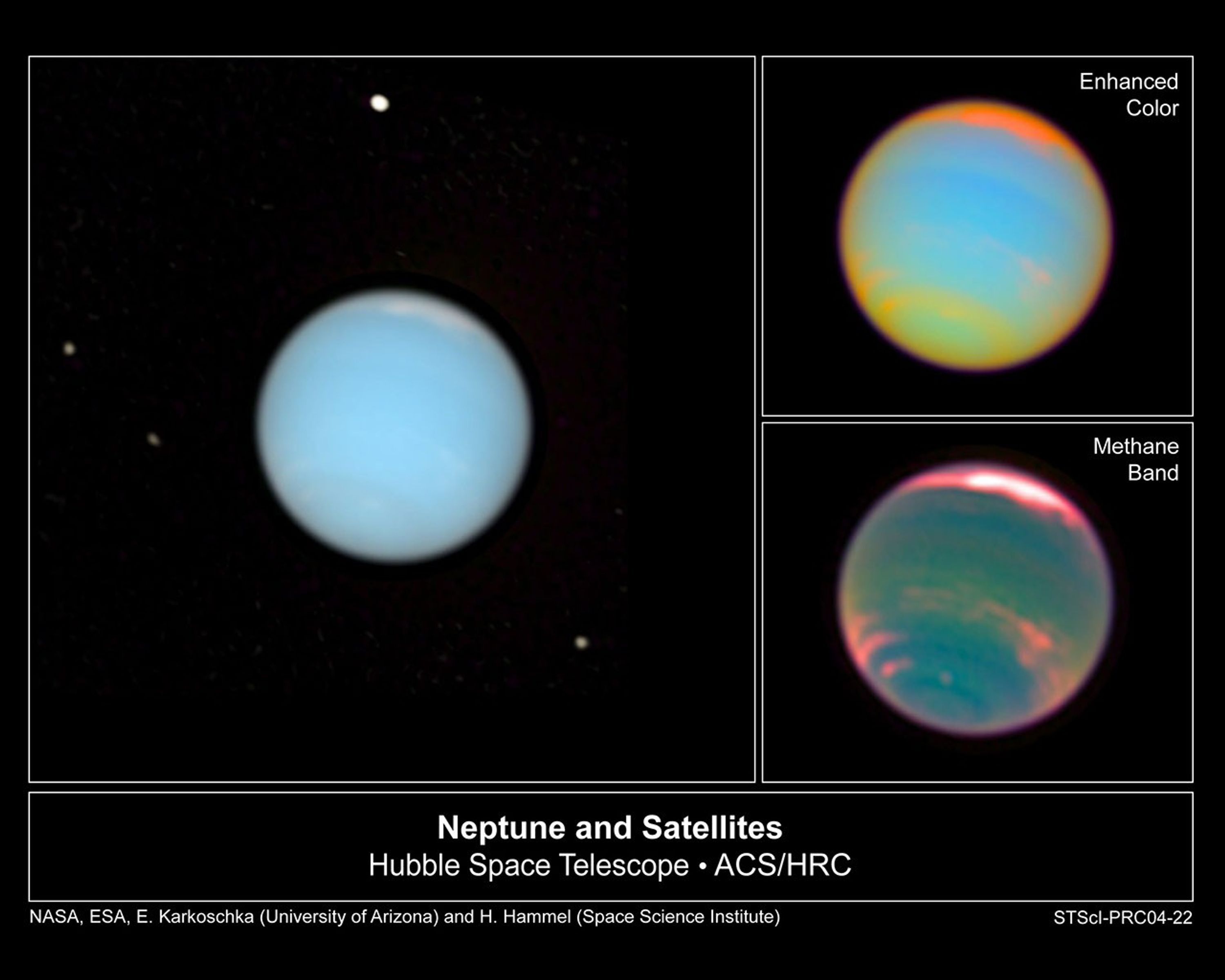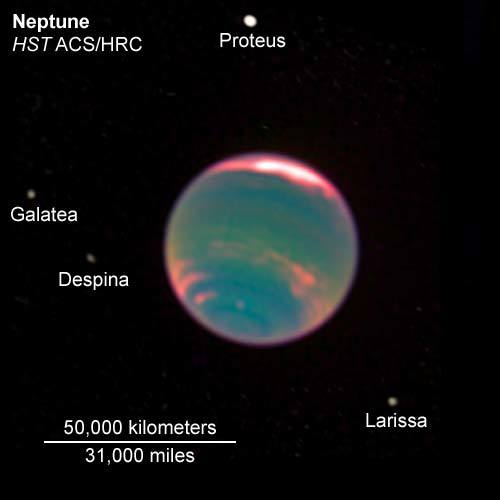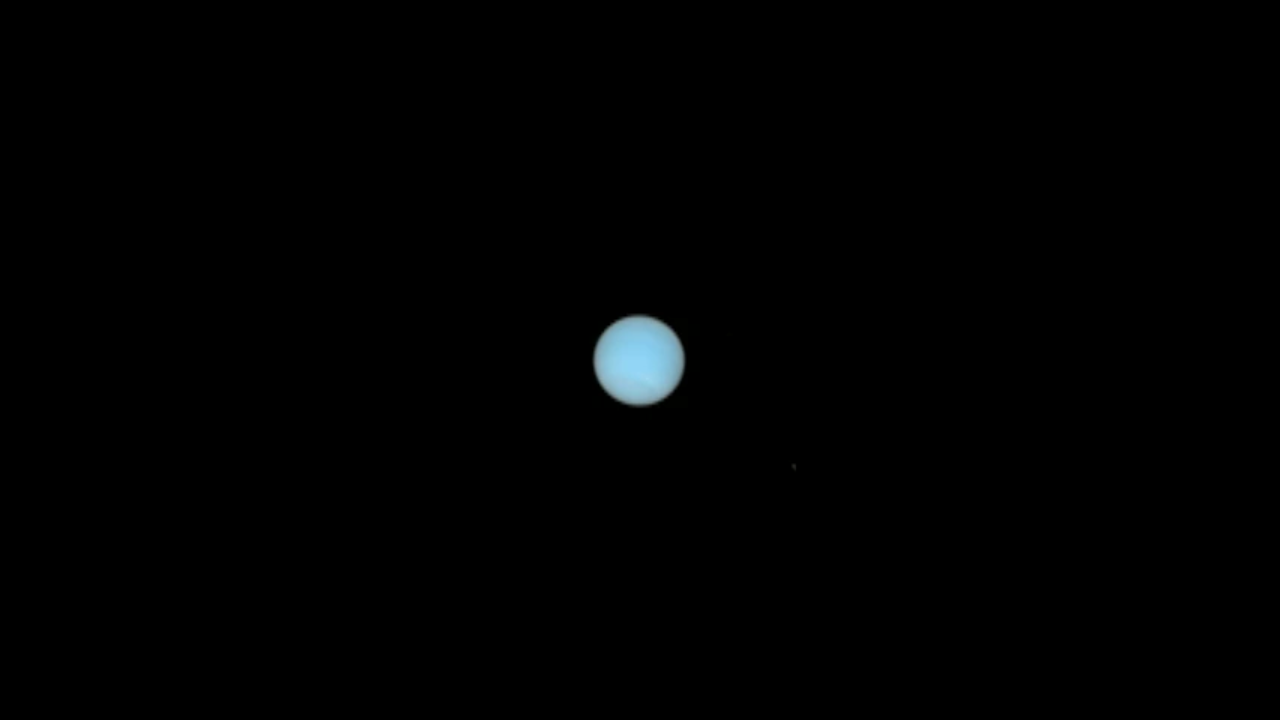1 min read
Neptune’s Dynamic Atmosphere

New NASA Hubble Space Telescope images of the distant planet Neptune show a dynamic atmosphere and capture the fleeting orbits of its satellites. The images have been assembled into a time-lapse movie revealing the orbital motion of the satellites.
Images were taken in 14 different colored filters probing various altitudes in Neptune's deep atmosphere so that scientists can study the haze and clouds in detail.
These are several snapshots from the Neptune movie.
The natural-color view of Neptune (to left), common to naked eye telescopic views by amateur astronomers, reveals a cyan colored planet. Methane gas in Neptune's atmosphere absorbs most of the red sunlight hitting the planet, making it look blue-green. The image was created by combining images in red, green, and blue light.
Neptune's subtle features are more visible in the enhanced-color view (top right). Images taken in special methane filters show details not visible to the human eye (bottom right). The features seen in this enhanced image must be above most of the sunlight-absorbing methane to be detectable through these special filters.
The planet is so dark at the methane wavelengths that long exposures can be taken, revealing some of Neptune's smaller moons. Clockwise from the top (in composite image at left), these moons are Proteus (the brightest), Larissa, Despina, and Galatea. Neptune had 13 moons at last count.
Neptune is the most distant giant planet in our Solar System, orbiting the Sun every 165 years. It is so large tht nearly 60 Earths could fit inside it. A day on Neptune is between 14 hours and 19 hours. The inner two thirds of Neptune is composed of a mixture of molten rock, water, liquid ammonia and methane. The outer third is a mixture of heated gases comprised of hydrogen, helium, water and methane.
On April 29 and 30, 2005, Hubble images were taken every 4-5 hours, spaced at about a quarter of Neptune's rotational period. These where combined to create a time-lapse movie of the dynamic planet.
About the Object
- DistanceDistanceThe physical distance from Earth to the astronomical object. Distances within our solar system are usually measured in Astronomical Units (AU). Distances between stars are usually measured in light-years. Interstellar distances can also be measured in parsecs.The semi-major axis of Neptune's orbit about the Sun is 30.06 Astronomical Units (A.U.) or roughly 4.5 billion km.
- DimensionsDimensionsThe physical size of the object or the apparent angle it subtends on the sky.Neptune has a diameter of roughly 30,800 miles (49,600 km) at the equator.
About the Data
- Data DescriptionData DescriptionProposal: A description of the observations, their scientific justification, and the links to the data available in the science archive.
Science Team: The astronomers who planned the observations and analyzed the data. "PI" refers to the Principal Investigator.10423: H.B. Hammel (Space Science Institute, Boulder, CO) and E. Karkoschka (University of Arizona) - InstrumentInstrumentThe science instrument used to produce the data.HST>ACS/HRC
- Exposure DatesExposure DatesThe date(s) that the telescope made its observations and the total exposure time.April 29 and 30, 2005
- FiltersFiltersThe camera filters that were used in the science observations.F250W, F330W, F435W, F475W, F550M, F625W, F658N, F775W, F814W, F850LP, F892N, and FR914M
- Object NameObject NameA name or catalog number that astronomers use to identify an astronomical object.Neptune
- Object DescriptionObject DescriptionThe type of astronomical object.Planet
- Release DateSeptember 1, 2005
- Science ReleaseHubble Makes Movie of Neptune’s Dynamic Atmosphere
- Credit

Related Images & Videos

Neptune's Dynamic Atmosphere
This time-lapse movie of Neptune was assembled from combining NASA Hubble Space Telescope images taken over a 15-hour period. The movie shows a dynamic atmosphere and captures the fleeting orbits of Neptune's satellites. The natural color and enhanced color views of Neptune were...
Share
Details
Claire Andreoli
NASA’s Goddard Space Flight Center
Greenbelt, Maryland
claire.andreoli@nasa.gov































